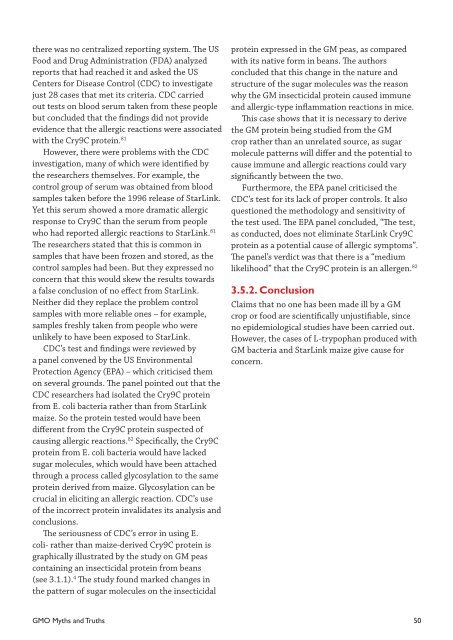GMO Myths and Truths
GMO Myths and Truths
GMO Myths and Truths
You also want an ePaper? Increase the reach of your titles
YUMPU automatically turns print PDFs into web optimized ePapers that Google loves.
there was no centralized reporting system. The US<br />
Food <strong>and</strong> Drug Administration (FDA) analyzed<br />
reports that had reached it <strong>and</strong> asked the US<br />
Centers for Disease Control (CDC) to investigate<br />
just 28 cases that met its criteria. CDC carried<br />
out tests on blood serum taken from these people<br />
but concluded that the findings did not provide<br />
evidence that the allergic reactions were associated<br />
with the Cry9C protein. 81<br />
However, there were problems with the CDC<br />
investigation, many of which were identified by<br />
the researchers themselves. For example, the<br />
control group of serum was obtained from blood<br />
samples taken before the 1996 release of StarLink.<br />
Yet this serum showed a more dramatic allergic<br />
response to Cry9C than the serum from people<br />
who had reported allergic reactions to StarLink. 81<br />
The researchers stated that this is common in<br />
samples that have been frozen <strong>and</strong> stored, as the<br />
control samples had been. But they expressed no<br />
concern that this would skew the results towards<br />
a false conclusion of no effect from StarLink.<br />
Neither did they replace the problem control<br />
samples with more reliable ones – for example,<br />
samples freshly taken from people who were<br />
unlikely to have been exposed to StarLink.<br />
CDC’s test <strong>and</strong> findings were reviewed by<br />
a panel convened by the US Environmental<br />
Protection Agency (EPA) – which criticised them<br />
on several grounds. The panel pointed out that the<br />
CDC researchers had isolated the Cry9C protein<br />
from E. coli bacteria rather than from StarLink<br />
maize. So the protein tested would have been<br />
different from the Cry9C protein suspected of<br />
causing allergic reactions. 82 Specifically, the Cry9C<br />
protein from E. coli bacteria would have lacked<br />
sugar molecules, which would have been attached<br />
through a process called glycosylation to the same<br />
protein derived from maize. Glycosylation can be<br />
crucial in eliciting an allergic reaction. CDC’s use<br />
of the incorrect protein invalidates its analysis <strong>and</strong><br />
conclusions.<br />
The seriousness of CDC’s error in using E.<br />
coli- rather than maize-derived Cry9C protein is<br />
graphically illustrated by the study on GM peas<br />
containing an insecticidal protein from beans<br />
(see 3.1.1). 4 The study found marked changes in<br />
the pattern of sugar molecules on the insecticidal<br />
protein expressed in the GM peas, as compared<br />
with its native form in beans. The authors<br />
concluded that this change in the nature <strong>and</strong><br />
structure of the sugar molecules was the reason<br />
why the GM insecticidal protein caused immune<br />
<strong>and</strong> allergic-type inflammation reactions in mice.<br />
This case shows that it is necessary to derive<br />
the GM protein being studied from the GM<br />
crop rather than an unrelated source, as sugar<br />
molecule patterns will differ <strong>and</strong> the potential to<br />
cause immune <strong>and</strong> allergic reactions could vary<br />
significantly between the two.<br />
Furthermore, the EPA panel criticised the<br />
CDC’s test for its lack of proper controls. It also<br />
questioned the methodology <strong>and</strong> sensitivity of<br />
the test used. The EPA panel concluded, “The test,<br />
as conducted, does not eliminate StarLink Cry9C<br />
protein as a potential cause of allergic symptoms”.<br />
The panel’s verdict was that there is a “medium<br />
likelihood” that the Cry9C protein is an allergen. 82<br />
3.5.2. Conclusion<br />
Claims that no one has been made ill by a GM<br />
crop or food are scientifically unjustifiable, since<br />
no epidemiological studies have been carried out.<br />
However, the cases of L-trypophan produced with<br />
GM bacteria <strong>and</strong> StarLink maize give cause for<br />
concern.<br />
<strong>GMO</strong> <strong>Myths</strong> <strong>and</strong> <strong>Truths</strong> 50


